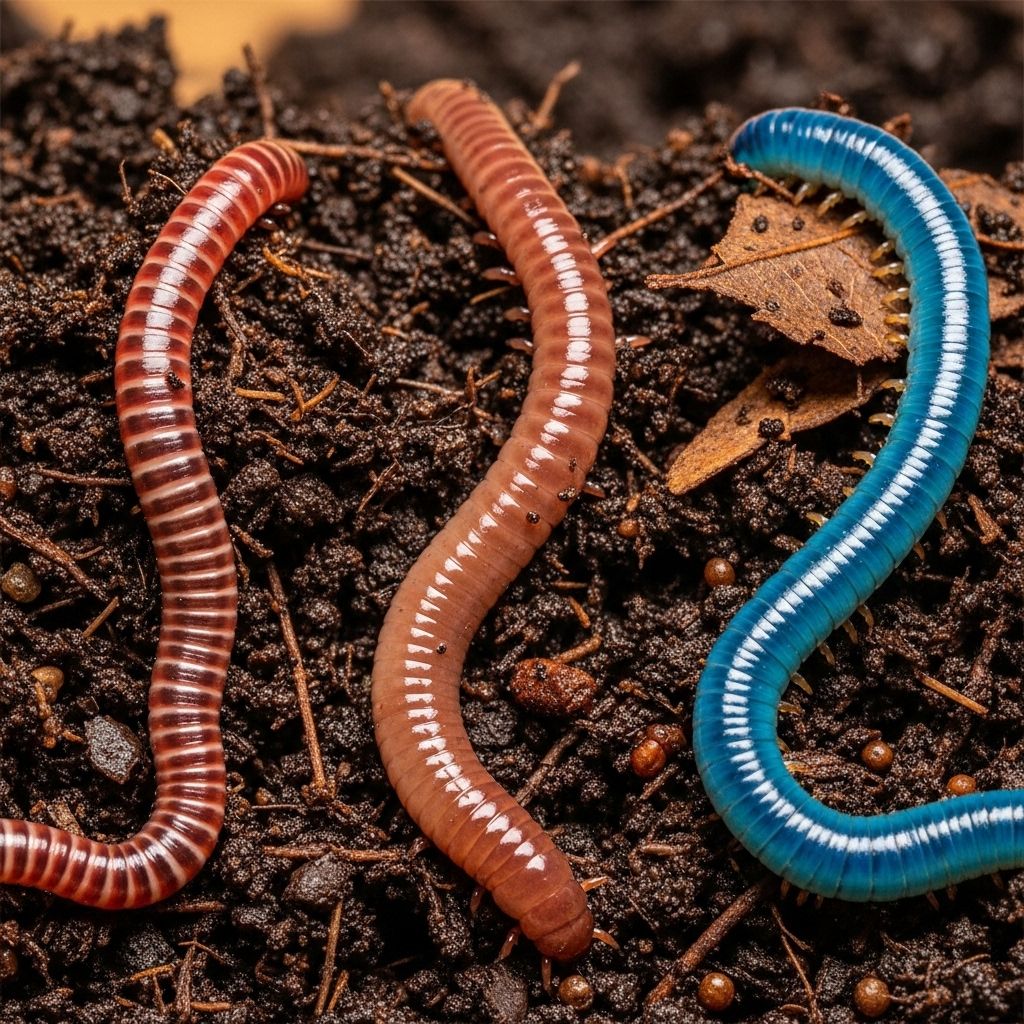The Best Composting Worms: Comprehensive Guide to Types, Selection & Care
Ideal bin inhabitants optimize breakdown speed and boost nutrient levels in every heap.

The Ultimate Guide to Composting Worm Types
Composting worms are the foundation of successful vermicomposting, turning kitchen scraps into nutrient-rich castings in worm bins. Choosing the right worm species and understanding their specific needs is essential for maximizing your compost’s efficiency and quality. This guide explores the best composting worms, key considerations for selection, care tips, and answers frequently asked questions about vermicomposting.
Why Not All Worms Are Suitable for Composting
Not all worms are created equal when it comes to composting. While garden worms and nightcrawlers may seem suitable due to their abundance in soil, they are fundamentally different from specialized composting worms.
- Garden worms (like the common earthworm Lumbricus terrestris) thrive in deep soil environments, where they burrow and feed on decaying organic matter below the surface. They are less efficient in breaking down food scraps at the surface.
- Composting worms are surface dwellers, specializing in consuming organic matter near the top of the soil or bin.
- These worms require specific moisture, temperature conditions, and readily available organic waste, making them distinct from garden soil species.
Main Types of Composting Worms: Species Overview
The world of composting worms is diverse, but a few species dominate the vermicomposting space due to their efficiency, hardiness, and adaptability. Below is a comprehensive analysis of the most common and effective composting worm species.
| Species | Scientific Name | Size | Ideal Temperature | Key Benefits | Challenges |
|---|---|---|---|---|---|
| Red Wigglers | Eisenia fetida | Small (2–4 inches) | 55–77°F | Hardy, thrive in bins, tolerate cold, easy to find | Less suited for outdoor soil environments |
| European Nightcrawlers | Eisenia hortensis | Medium (3–6 inches) | 50–75°F | Adaptable, good in cool climates, robust | Slower reproduction rate than red wigglers |
| African Nightcrawler | Eudrilus eugeniae | Large (up to 8 inches) | 68–85°F | Produces attractive, granular castings, works deeper in bins | Sensitive to cold, needs higher temperatures |
Red Wigglers: The Top Choice
Red wigglers (Eisenia fetida) are the most recommended composting worm species due to their superb adaptability. They thrive in a variety of climates, can handle cold spells, and are available at affordable prices. Their robust nature makes them ideal for beginners and advanced composters alike.
- Hardiness: Survive temperature extremes and rapidly rebound in spring.
- Efficiency: Quickly convert organic waste into worm castings.
- Availability: Easy to purchase from worm farms, garden centers, or online retailers.
- Cost: Typically more affordable compared to rarer species.
Expert Recommendation: Red wigglers are universally favored for all but the harshest environments.
European Nightcrawler: Cool Climate Specialist
The European nightcrawler (Eisenia hortensis) excels in cooler climates, making it a popular choice for regions with mild to cold winters. It is slightly larger than red wigglers and produces excellent compost.
- Adapts well to European and North American climates.
- Ideal for outdoor bins where temperatures can dip during the year.
- Tolerant of temperature fluctuations but reproduce slower than red wigglers.
African Nightcrawler: Deep Worker & Warm Climate Champion
African nightcrawlers (Eudrilus eugeniae) are renowned for their large size and the quality of their castings—attractively granular and rich in nutrients. These worms work deeper in compost bins, complementing the surface-dwelling red wigglers. However, they are highly sensitive to cold and require consistently warm temperatures (above 60°F) to thrive.
- Ideal for tropical and subtropical regions.
- Best used indoors or in climate-controlled bins within cooler climates.
- Frequently used by advanced composters looking to mix worm populations for greater casting quality.
How to Choose the Best Worms for Your Compost Bin
- Climate: Match worm species to your local temperature ranges. Red wigglers for most climates; European nightcrawlers for colder regions; African nightcrawlers for warm areas.
- Bin Design: Surface-dwellers (red wigglers) work well in tiered worm bins and stackers, while deeper workers (African nightcrawler) are suited for larger, single-layer bins.
- Purpose: If your aim is garden castings with excellent structure and appearance, consider African nightcrawlers. For efficient food scrap recycling, red wigglers are superior.
- Availability: Opt for species that are easy to purchase and reliably sourced.
Worm Castings: Nature’s Nutrient-Rich Fertilizer
Worm castings—the by-product of composting worms’ digestive processes—are a powerhouse for soil health. These castings:
- Provide balanced nutrients (approximate 1-1-1 NPK ratios).
- Add beneficial microbes for soil life and plant growth.
- Improve soil structure, aeration, and water retention.
- Are odor-free and can be safely added to houseplants, vegetable beds, and outdoor gardens.
Care and Feeding: Keeping Composting Worms Healthy
Successful vermicomposting depends on creating a stable, nurturing environment for your worms. Here are essential care tips:
- Feed Non-Acidic Scraps: Focus on fruit and vegetable peels, grains, coffee grounds, tea bags, and aged grass clippings.
- Avoid: Acidic or oily foods, meats, dairy, and fresh table scraps which can attract pests or upset the bin’s balance.
- Add Shredded Browns: Newsprint (with black ink only), cardboard, egg shells (for grit and calcium).
- Chop or Puree Items: Smaller pieces decompose faster, reducing odor and pest issues.
- Freeze Before Adding: Allow food scraps to dehydrate and mature by freezing for 48 hours before adding.
Bedding Moisture: The bedding should be damp, like a wrung-out sponge. Excess water leads to oxygen depletion, while dryness causes suffocation.
Worm Bin Setup: Bedding, Layers, and Maintenance
Proper setup is crucial:
- Layer Bedding and Scraps: Alternate layers of bedding (shredded paper/cardboard/coconut coir) and food waste.
- Maintain Moisture: Water lightly if required; check for sponge-like dampness.
- Turn Gently: Mix bedding and scraps occasionally to ensure even decomposition and aeration.
- Harvest Castings: Use flow-through or stacker bins to make extraction easy. Worms climb upwards, leaving castings behind for harvest every few weeks.
Common Mistakes in Worm Composting (and Solutions)
Many new worm bin owners face common troubleshooting issues:
- Adding Too Many Scraps: Can lead to smells and fruit fly infestations. Solution: Add scraps gradually and balance with dry bedding.
- Inadequate Moisture: Overwatering or under-watering harms worms. Solution: Check moisture regularly; bedding is best when damp, not soggy.
- Overpacking Bin: Worms need air pockets to tunnel and breathe. Solution: Fluff bedding, do not compress.
- Ignoring Pests: Fruit flies, maggots (black soldier fly larvae). Solution: Freeze scraps before adding, keep browns-to-greens balanced, and turn compost often.
Maggots in Compost: Should You Worry?
Black soldier fly larvae are the most common maggots found in compost. While cultivation of these larvae is intentional on farms for animal feed, their presence in the worm bin is usually due to:
- Excess food waste or moist, warm conditions.
- Not enough ‘browns’ added or infrequent mixing.
Although not harmful to the compost itself, black soldier fly larvae can outcompete composting worms, reducing casting output. To address their presence, adjust the green-to-brown ratio and keep the bin covered to avoid fly access.
Types of Worm Bins and Harvesting Methods
Composting bins come in a variety of designs, optimized for both small-scale and commercial production. Two common types are:
- Stacked or Tray Bins: Worms naturally migrate up as they exhaust food in lower trays. This makes casting collection clean and straightforward without disturbing the worm population.
- Flow-Through Bins: Castings drop to the bottom as worms move upward toward fresh food. Harvest castings every few weeks, adding fertilizer and micronutrients to your garden easily.
Maintaining Your Worm Population & Productivity
- Introduce new bedding and scraps regularly for continued worm migration and healthy population growth.
- Monitor temperature and humidity, especially if you keep bins outdoors—it may be necessary to bring them inside during extreme weather.
- Every 4–6 months, harvest castings, separate out worms, and reset the bin.
Frequently Asked Questions (FAQs)
Q: Can I use worms from my garden soil for vermicomposting?
A: No. Garden worms are not suitable for worm bins. Composting worms are surface-dwellers that efficiently consume food scraps and reproduce in high-density environments.
Q: Which composting worm species is best for beginners?
A: Red wigglers (Eisenia fetida) are ideal. They are hardy, adaptable to temperature changes, affordable, and widely available.
Q: How many worms should I start with in my bin?
A: A pound (about 300–400 worms) is a good starter quantity for most home bins, ensuring rapid population growth and efficient composting.
Q: What temperature range do composting worms need?
A: Most composting worms thrive between 55°F and 77°F. African nightcrawlers require 68°F or higher and are vulnerable to temperatures below 60°F.
Q: How do I prevent pests and maggots in my worm bin?
A: Freeze scraps before adding them, balance food-to-bedding ratios, turn the compost, and maintain a covered bin to limit fly access.
Q: Is there a benefit to mixing worm species?
A: Yes. Combining surface-dwelling worms (red wigglers) and deep workers (African nightcrawlers) can result in superior casting quality and decomposition rates.
Conclusion: Unlocking the Potential of Worm Composting
By carefully selecting the right worm species, providing consistent care, and optimizing your bin design, you can transform kitchen waste into a valuable soil amendment rapidly and efficiently. Red wigglers remain the top choice, but European and African nightcrawlers offer valuable alternatives for specific climates and worm bin strategies. Avoid common pitfalls, maintain ideal conditions, and watch your worm bin become a living engine of garden fertility.
References
Read full bio of Srija Burman












